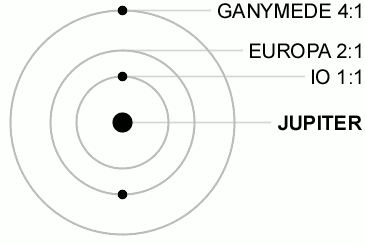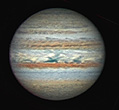Intrepid librarian (or going to Jupiter)
Posted: Mon Jul 16, 2012 6:31 am
We used to have a librarian named Birgitta at the school where I work. She got herself another job several years ago and moved away.
Birgitta was - is - a very interesting person. Tall, overweight, stately, cool, and full of unusual hobbies. When she worked at my school she was building fantastic little models of splendid Victorian furniture, at the same time as she herself usually wore colorful and comfortable denim clothes. (So the people who originally owned the Victorian furniture wouldn't have let Birgitta near their elegant chairs and tables.)
We kept in touch for a while after she had moved away, but then she wanted to stay in touch via Facebook. And I just can't do Facebook.
But two nights ago, I met her in person.
She had taken up a new hobby: traveling. She told me, in her typical matter-of-fact way, that her latest journey had gone to Jupiter.
-Jupiter, I said. How's that possible?
-It was NASA, she told me. They are planning manned missions to Jupiter, and they wanted to send a manned "test probe" first, and they were asking for volunteers. I told them I was interested, and they picked me. And a few others too, of course.
As I said, Birgitta is tall. And overweight. She must weigh a few pounds, that's for sure. And she is pushing sixty. But, well, NASA picked her.
-Weren't you scared? I asked. I mean, being locked up inside that tiny capsule for months and months...
-It wasn't so bad, she replied. At first we were basically confined to our bunks, but then we were allowed to move around inside the entire ship.
Move around inside the "entire" ship. That tiny little flying bucket. I felt my claustrophobia working overdrive just thinking about it. I couldn't even ask Birgitta if she hadn't been afraid of dying out in space.
-Wasn't it boring, flying all the way to Jupiter? I asked instead.
-Getting past the orbit of Mars was a bit of a drag, she admitted. But then we seemed to kick into a new gear, and we were at Jupiter in a jiffy.
-Getting there was fun, she continued. I took some really good pictures. Let me show you some...
And she took out her smartphone and started showing me pictures of Jupiter. They really were splendid. I was, of course, particularly fascinated by the blue-gray slightly fan-like patterns in Jupiter's cloud cover - you can see one here, above the moon Io.
And then I woke up.
The dream hasn't quite left me. Of course a manned mission to Jupiter seems like a very remote dream, given that we aren't even close to sending anyone even to Mars. (And if we ever go to Jupiter, we won't send people like Birgitta there - and the round trip won't take just a couple of months - and the shortest part of the journey won't be the one between the orbit of Mars and Jupiter - and so on.)
But let's toy with the idea that we were going. Clearly, if we were going to land on one of the moons, we would choose Europa, since Europa probably has an ocean not too far below its ice cover. But let's assume that we weren't thinking about exploring the possibilities of life inside Europa, but we were only interested in landing on a Jovian moon, any moon, as safely as possible.
What moon would we choose? If we stuck to the Galilean moons, we surely wouldn't choose Io, if we were looking for safety. (We wouldn't want the ground we landed on to erupt from under our feet!) And if we are talking safety only, I don't know how safe Europa would be. Isn't Europa full of sheer ice cliffs? How much fun would that be? As for Callisto, it seems craggly and dark and full ice craters. I don't know, but I think that Ganymede looks safest. It has a variety of terrain to choose from and looks "middle-of-the-road" light brown and well-groomed.
Any thoughts? Where would you land if you went to the Jovian system and wanted to choose the safest landing site?
(And what do you call those bluish fan-like cloud patterns on Jupiter? I know they have a name, but I can't remember it!)
Ann
Birgitta was - is - a very interesting person. Tall, overweight, stately, cool, and full of unusual hobbies. When she worked at my school she was building fantastic little models of splendid Victorian furniture, at the same time as she herself usually wore colorful and comfortable denim clothes. (So the people who originally owned the Victorian furniture wouldn't have let Birgitta near their elegant chairs and tables.)
We kept in touch for a while after she had moved away, but then she wanted to stay in touch via Facebook. And I just can't do Facebook.
But two nights ago, I met her in person.
She had taken up a new hobby: traveling. She told me, in her typical matter-of-fact way, that her latest journey had gone to Jupiter.
-Jupiter, I said. How's that possible?
-It was NASA, she told me. They are planning manned missions to Jupiter, and they wanted to send a manned "test probe" first, and they were asking for volunteers. I told them I was interested, and they picked me. And a few others too, of course.
As I said, Birgitta is tall. And overweight. She must weigh a few pounds, that's for sure. And she is pushing sixty. But, well, NASA picked her.
-Weren't you scared? I asked. I mean, being locked up inside that tiny capsule for months and months...
-It wasn't so bad, she replied. At first we were basically confined to our bunks, but then we were allowed to move around inside the entire ship.
Move around inside the "entire" ship. That tiny little flying bucket. I felt my claustrophobia working overdrive just thinking about it. I couldn't even ask Birgitta if she hadn't been afraid of dying out in space.
-Wasn't it boring, flying all the way to Jupiter? I asked instead.
-Getting past the orbit of Mars was a bit of a drag, she admitted. But then we seemed to kick into a new gear, and we were at Jupiter in a jiffy.
-Getting there was fun, she continued. I took some really good pictures. Let me show you some...
And she took out her smartphone and started showing me pictures of Jupiter. They really were splendid. I was, of course, particularly fascinated by the blue-gray slightly fan-like patterns in Jupiter's cloud cover - you can see one here, above the moon Io.
And then I woke up.
The dream hasn't quite left me. Of course a manned mission to Jupiter seems like a very remote dream, given that we aren't even close to sending anyone even to Mars. (And if we ever go to Jupiter, we won't send people like Birgitta there - and the round trip won't take just a couple of months - and the shortest part of the journey won't be the one between the orbit of Mars and Jupiter - and so on.)
But let's toy with the idea that we were going. Clearly, if we were going to land on one of the moons, we would choose Europa, since Europa probably has an ocean not too far below its ice cover. But let's assume that we weren't thinking about exploring the possibilities of life inside Europa, but we were only interested in landing on a Jovian moon, any moon, as safely as possible.
What moon would we choose? If we stuck to the Galilean moons, we surely wouldn't choose Io, if we were looking for safety. (We wouldn't want the ground we landed on to erupt from under our feet!) And if we are talking safety only, I don't know how safe Europa would be. Isn't Europa full of sheer ice cliffs? How much fun would that be? As for Callisto, it seems craggly and dark and full ice craters. I don't know, but I think that Ganymede looks safest. It has a variety of terrain to choose from and looks "middle-of-the-road" light brown and well-groomed.
Any thoughts? Where would you land if you went to the Jovian system and wanted to choose the safest landing site?
(And what do you call those bluish fan-like cloud patterns on Jupiter? I know they have a name, but I can't remember it!)
Ann



 are mean longitudes of the moons. This relation makes a triple conjunction impossible. (The Laplace resonance in the Gliese 876 system, in contrast, is associated with one triple conjunction per orbit of the outermost planet.)
are mean longitudes of the moons. This relation makes a triple conjunction impossible. (The Laplace resonance in the Gliese 876 system, in contrast, is associated with one triple conjunction per orbit of the outermost planet.)



